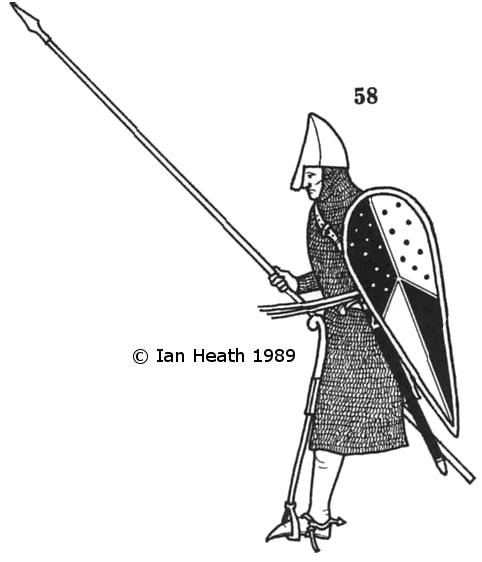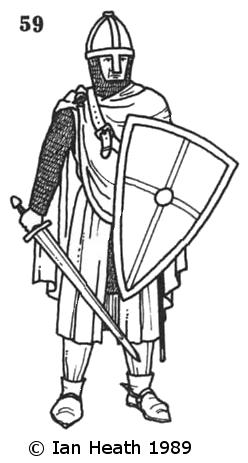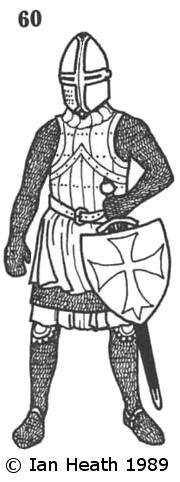
Amazon Audible Gift Memberships
SCANDINAVIAN KNIGHTS, 12th-13th CENTURIES
An extract from Armies of Feudal Europe 1066-1300by Ian Heath
[Based on the Baldishol Tapestry]
[Based on the Valthjofsstadir Church Door]
[Based on St Maurice on a Reliquary, Lögum Monastery, c. 1300]
58, 59 & 60. SCANDINAVIAN KNIGHTS, 12th-13th CENTURIES
From the sources one is left with a general but less than accurate impression that Scandinavia lagged somewhat behind the rest of Europe in terms of armour: witness, for example, figure 58, from the oft-reproduced tapestry of c.1180 from Baldishol, Norway, which depicts a warrior little different from a mid-11th century Norman knight. However, the best and most detailed account of Scandinavian knightly equipment that we have, contained in a source called the 'Speculum Regale' (apparently written by a cleric of Hakon IV of Norway, who reigned 1217-63), describes armour comparable to that in use elsewhere: a mail hauberk over an iron breastplate (see 12b); a sleeved, thigh-length linen gambeson; a sleeveless aketon over the hauberk; mail hosen suspended from a waist-belt; quilted linen cuisses with thick iron poleyns attached; a steel heaume; a thick shield with a guige-strap; and a long, steel-bladed lance, a dagger, and two swords (one at the waist and the other at the saddle-bow - see 103). In addition it records both quilted and mail armour for horses, calling the former by the term kovertur, from the French couverture. Certainly such equipment would have made a Scandinavian knight indistinguishable from his Western European counterparts, and contemporary Danish, Swedish and, to a lesser extent, Norwegian seals confirm this.
Of the other two knightly figures depicted here, 59 is an Icelander from the doors of Valthjofsstadir Church dating to c. 1200 (ie, about the time that a series of savage feuds began between the private armies of rival Icelandic chieftains - the largest on record being over 1,000-strong - that eventually resulted in the island accepting Norwegian suzerainty in 1262-64). Looking at this figure one cannot help but be reminded of the 13th century Icelandic saga-writer Snorri Sturlusson's anachronistic description of an earlier king who had a helmet on his head, a red shield on which was inlaid a gilded lion, and girt at his waist the sword Legbiter, of which the hilt was ivory and the handgrip was wound about with gold thread; this sword was extremely sharp. In his hand he had a short spear, and a short, red silk cloak over his coat [ie, his surcoat], on which, both before and behind, was embroidered a lion in yellow silk.'
60 is a Danish knight dating to the end of the 13th century, from the door of a reliquary in the Convent of Logum in southern Jutland. The most notable thing about his armour is that he wears a splint-lined surcoat that is clearly similar, if not identical, in construction to the Wisby type shown in figure 13. His harness is otherwise typical of that in use throughout Western Europe. The helmet is added from another source.
Next: 61. SCANDINAVIAN HIRDMAN, 13th CENTURY in Armies of Feudal Europe 1066-1300 by Ian Heath



